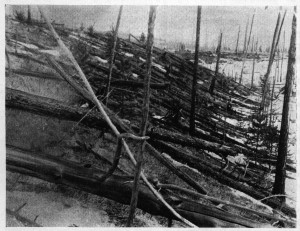Big booms over the Northland
April 18, 2013

Ned Rozell
4/18/2013
Near a small village in Russia, Marina Ivanova stepped into cross-country skis and kicked toward a hole in the snow. The meteorite specialist with the Smithsonian Museum of Natural History and Vernadsky Institute in Moscow was hunting for fragments of the great Chelyabinsk Meteorite that exploded three days earlier.
This search was different from others. Ivanova has looked for metallic stones on the world’s great deserts and in Antarctica, places where heavenly rocks stand out because of their contrast with the surface. When the Chelyabinsk Meteorite in mid-February rained out fragments over the Ural Mountains, pieces marked their fall with little vole holes in the snow.
“I’ve never seen anything like this before,” Ivanova said during a recent lecture at the University of Alaska Fairbanks. “This event was amazing.”
The fragments fired into the snowpack like bullets. After a bit of digging, Ivanova and other searchers found them stuck to “carrots” of melted snow. They chopped the carrots with their mittens to reveal the rocks from space. By the end of the day, Ivanova and her colleagues found about 400 stones, from fist to raisin size.
“We have small pieces,” she said. “Nobody knows where the big masses are located.”
The Feb. 15, 2013, meteorite was the largest impact event of the last century. More than 1,000 people were injured, most of them cut by glass the shock wave shattered. Hundreds of people recorded the arc and explosion of the meteorite on dashboard cameras of their cars and trucks. Ivanova said scientists found YouTube videos of the meteorite useful in calculating its trajectory.
While the Chelyabinsk Meteorite was a big deal, it was much smaller than one that ripped through the atmosphere above Siberia in June 1908. Near the Stony Tunguska River, a meteorite or something like it exploded on or close to the ground surface, flattening trees within 30 miles of the epicenter. Eighty million trees bowed away from the blast site.
The Tunguska area was so remote that scientists didn’t investigate for almost 20 years. Leonid Kulik, the curator for the meteorite collection at the St. Petersburg Museum, traveled to Tunguska several times in the 1920s. He interviewed a man who, sitting on a porch at a trading post 40 miles from ground zero, was knocked from his chair and felt heat so intense he thought his shirt was on fire.
On a wilderness expedition to the expected impact site, Kulik was surprised to find no giant crater, but hundreds of square miles of downed, scorched trees. Scientists have found no meteorite material near Tunguska. This has led some to say some comet-like object caused the tremendous explosion.
“It was probably ice and dust,” Ivanova said.
Millions of years ago, a smaller but still impressive event left its mark on Alaska. The Avak impact crater east of Barrow measures six miles from rim to rim. It formed when a meteorite or comet the diameter of downtown Fairbanks crashed into northern Alaska.
The crater, buried by sediment, is not visible from the window as your Alaska Airlines jet circles Barrow. The blast left an enduring mark by impacting rocks beneath the surface in such a way that they now act as a trap for natural gas. Fifty years ago, researchers for the U.S. Navy tapped a pocket to heat buildings in Barrow. Ever since, Barrow residents have used the ready source of energy.
Since the late 1970s, the University of Alaska Fairbanks' Geophysical Institute has provided this column free in cooperation with the UAF research community. Ned Rozell is a science writer for the Geophysical Institute.


